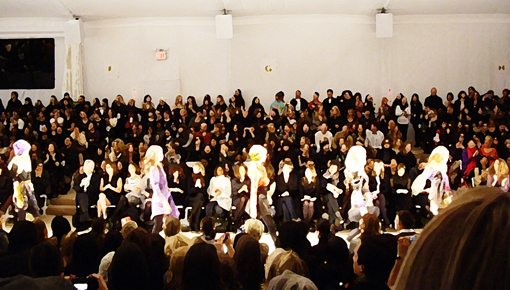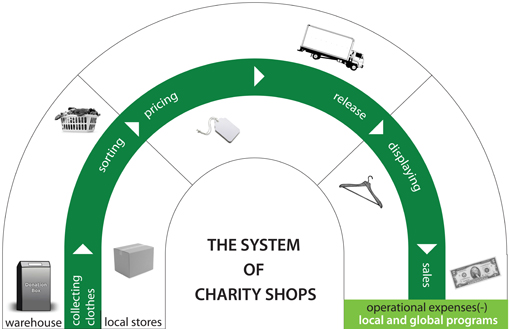Appropriate Fashion
Posted on October 6, 2011 | posted by:Donella H. Meadows, the author of the book, Thinking In Systems, warns that people tend to only think about things quantifiably and ignore something essential. In effect, too many people risk their lives to quantify things and tend to forget the fundamental goal behind their daily routine while they compete to get a better “number” no matter what they pay for it. On the other hand, it applies a little differently for fashion.
“Less Is More” is the lasting idea many glittering fashion designers, especially Coco Chanel, have been emphasizing in terms of design. Designers have thought continuously about what is important and what is necessary for fashion design. What about “Less Is More” for quantity? It doesn’t mean a custom made or limited edition. What if borrowing a term from Appropriate Technology, which is designed with special consideration to the context of its use – including environmental, ethical, cultural, social, political, and economical aspects of the community it is intended for (http://www.appropedia.org/) – and using the term Appropriate Fashion, what is the proper fashion for people to wear clothes? Once we open our wardrobe we realize that there are enough clothes for living. In fashion, TPO (Time, Place and Occasion) is emphasized. In other words, we wear items to match situations. There is an etiquette and manner to dressing considering environment. Since appearance represents a social status, it is an inevitable that reason will follow the culture. However, what is the excuse for countless jeans and t-shirts? In fact, jeans were originally a work wear for miners. There are immeasurable examples that blur the boundary of practical necessity and luxury.
In addition to the manufacturing side of fashion, retailers accelerate consuming clothes. Just like drinking soda, people shop at stores of fast fashion brand all around the world. Nowadays, they intensify thirst for fashion quickly, just like an addiction to Coke. Although sustainability stands out as a global issue, only the fashion industry that SPA (Specialty store retailer of Private label Apparel), such as Zara and H&M, goes against the trend. No matter how many eco-friendly bags the fashion company makes, unless they manufacture something, it is no longer “green” since it is impossible to produce without making trash. Now is the time to talk about true sustainability in terms of fashion that closely relates to our life and not give the excuse that it is essential to follow trends.
According to British economist E. F. Schumacher’s book Small Is Beautiful, there are three factors to archive sustainable economy: (page 31).
- Cheap enough so that they are accessible to virtually everyone;
- Suitable for small-scale application; and
- Compatible with man’s need for creativity.
These factors will help to create Appropriate Fashion as well. However, the problem starts from our desire. At this point, Schumacher continues suggesting in his book, (page 40)
How could we even begin to disarm greed and envy? Perhaps by being much less greedy and envious ourselves; perhaps by resisting the temptation of letting our luxuries become needs; and perhaps by even scrutinizing our needs to see if they cannot be simplified and reduced. If we do not have the strength to do any of this, could we perhaps stop applauding the type of economic “progress” which palpably lacks the basis of permanence … An ounce of practice is generally worth more than a ton of theory.
Everybody knows that we need immediate action. Nevertheless, it is really hard to give up fashion. If the desire for shopping were undeniable, let’s try to find other solutions. In this case, personally, I would rather visit charity shops or thrift shops in my neighborhood. Most people don’t know the real value of these shops and just go as an alternative option for shopping. However, these shops operate as non-profit organizations that are cut off from the vicious circle of extravagant consuming. The desire for fashion still exists, but the shops focus on other objectives, such as the desire for disposing unused clothes, minimizing taxes and helping people. Indeed, it is a true sustainable fashion since people can buy something with a reasonable price as well. These non-profit organizations design a service not clothes. So, this system can be a possible answer for Appropriate Fashion.
Every organization that has charity shops has different systems, but shares the same basic framework.
Collecting donated clothes from citizens – local charity shops or a main warehouse – is the first step of the sorting process. Secondly, depending on category, clothes go through the pricing process and are then displayed in each shop. All the products are sold for a much more reasonable price compared to the original price, and all the profit is used for the programs that the non-profit organization runs (operating expenses, such as salary and rent, are excepted). The action to fulfill desire is the same, but this process does not generate any trash. Whether the customer recognizes it or not, they help the neighborhood while consuming recycled clothes.
So, what is Appropriate Fashion? I wouldn’t say stop buying anything, even though it is still the very important to ask how many clothes do we consume and what should we do with leftovers after the massive manufacturing. However, there are many ways to solve this problem through systemic thinking or service design thinking. Before spending money at an online shopping mall or department store, etc., just think about whether you really need that object. Revaluate your old-fashioned jacket or jeans and rediscover other ways to use it. Think about values under the surface of clothes. Moreover, the fashion that you donate to charity shops can save someone’s life. We don’t need to create Appropriate Fashion; it’s already in our wardrobe.

